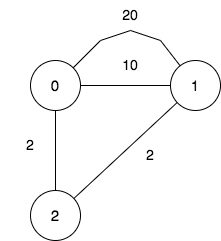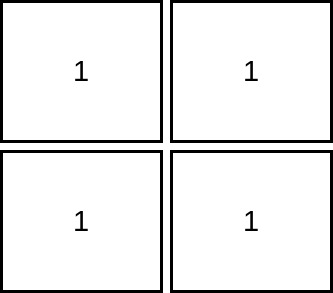目标
一个公司在全国有 n 个分部,它们之间有的有道路连接。一开始,所有分部通过这些道路两两之间互相可以到达。
公司意识到在分部之间旅行花费了太多时间,所以它们决定关闭一些分部(也可能不关闭任何分部),同时保证剩下的分部之间两两互相可以到达且最远距离不超过 maxDistance 。
两个分部之间的 距离 是通过道路长度之和的 最小值 。
给你整数 n ,maxDistance 和下标从 0 开始的二维整数数组 roads ,其中 roads[i] = [ui, vi, wi] 表示一条从 ui 到 vi 长度为 wi的 无向 道路。
请你返回关闭分部的可行方案数目,满足每个方案里剩余分部之间的最远距离不超过 maxDistance。
注意,关闭一个分部后,与之相连的所有道路不可通行。
注意,两个分部之间可能会有多条道路。
示例 1:

输入:n = 3, maxDistance = 5, roads = [[0,1,2],[1,2,10],[0,2,10]]
输出:5
解释:可行的关闭分部方案有:
- 关闭分部集合 [2] ,剩余分部为 [0,1] ,它们之间的距离为 2 。
- 关闭分部集合 [0,1] ,剩余分部为 [2] 。
- 关闭分部集合 [1,2] ,剩余分部为 [0] 。
- 关闭分部集合 [0,2] ,剩余分部为 [1] 。
- 关闭分部集合 [0,1,2] ,关闭后没有剩余分部。
总共有 5 种可行的关闭方案。示例 2:

输入:n = 3, maxDistance = 5, roads = [[0,1,20],[0,1,10],[1,2,2],[0,2,2]]
输出:7
解释:可行的关闭分部方案有:
- 关闭分部集合 [] ,剩余分部为 [0,1,2] ,它们之间的最远距离为 4 。
- 关闭分部集合 [0] ,剩余分部为 [1,2] ,它们之间的距离为 2 。
- 关闭分部集合 [1] ,剩余分部为 [0,2] ,它们之间的距离为 2 。
- 关闭分部集合 [0,1] ,剩余分部为 [2] 。
- 关闭分部集合 [1,2] ,剩余分部为 [0] 。
- 关闭分部集合 [0,2] ,剩余分部为 [1] 。
- 关闭分部集合 [0,1,2] ,关闭后没有剩余分部。
总共有 7 种可行的关闭方案。示例 3:
输入:n = 1, maxDistance = 10, roads = []
输出:2
解释:可行的关闭分部方案有:
- 关闭分部集合 [] ,剩余分部为 [0] 。
- 关闭分部集合 [0] ,关闭后没有剩余分部。
总共有 2 种可行的关闭方案。说明:
- 1 <= n <= 10
- 1 <= maxDistance <= 105
- 0 <= roads.length <= 1000
- roads[i].length == 3
- 0 <= ui, vi <= n - 1
- ui != vi
- 1 <= wi <= 1000
- 一开始所有分部之间通过道路互相可以到达。
思路
没时间做了// todo
代码






